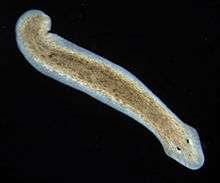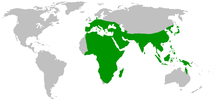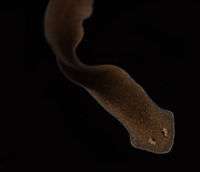Dugesia
Dugesia (pronounced, /duˈd͡ʒiʒ(i)ə/) is a genus of dugesiid triclads that contains some common representatives of the class Turbellaria. These common flatworms are found in freshwater habitats of Africa, Europe, Middle East, Asia, and Australia. Dugesia is best known to non-specialists because of its regeneration capacities.[2]
| Dugesia(free living). | |
|---|---|
 | |
| Dugesia subtentaculata | |
| Scientific classification | |
| Kingdom: | |
| Phylum: | |
| Class: | |
| Order: | |
| Suborder: | |
| Superfamily: | |
| Family: | |
| Genus: | Dugesia |
| Species | |
 | |
| Distribution of genus Dugesia after Sluys et al. 1998.[2] | |
Dugesia is the type genus of the family Dugesiidae.
Description
Dugesia species have an elongated body with a slightly triangle-shaped head. Usually they have grey, brown or black colors on the dorsal body surface, the ventral surface uses to be paler. These animals have a couple of eyes constituted by a multicellular pigmented cup with many retinal cells to detect the amount of light in the nearby environment. Sometimes they present supernumerary eyes. At the anterior part of the body, behind the eyes level, they have two of structures called auricles that give the triangle look to the 'head' and that allow them to detect the intensity of water current. These auricles are free of pigment and rhabdites. Each side of the anterior margin of the head have between 5 and 10 shallow sensory fossae, their number depends on the species or the individual. The sensory fossae and the auricle grooves are supplied with many nerve endings.[3]
Dugesia digestion tract consists of a central non-pigmented tubular pharynx. Like the other triclads, Dugesia's gut consists in three ramified branches. Each branch consists of ceca, which delivers the nutrients to the body. This worm has a sac digestive plan, that is, it does not have a separate opening for waste excretion.[4]
Subepidermal musculature is divided in four layers.[3]
In Dugesia the ovaries are ventrally situated, they start just behind the brain, usually at the level of the fourth intestinal branch. The bursal canal runs on the right side of the copulatory apparatus and above the atrium.[3] Like some Neppia species, Dugesia have a third layer of longitudinal musculature over the vaginal area of the bursal canal. This feature is not present in other triclads. Another feature shared with Neppia is the presence of a glandular area at the transicional area between the seminal vesicle and the ejaculatory duct, although in Dugesia these glands are concentrated at the diaphragm, a structure not present in any other genera.[5] Ball proposed that the presence of this glands was a synapomorphy of Dugesia and Neppia. The absence of these glands in some Neppia species (N. jeanneli, N. montana and N. schubarti) is thought to be a secondary loss.[6]
Reproduction
They are hermaphrodites. Many species can reproduce both sexually and asexually (by parthenogenesis or by fission).[7]
Phylogeny and taxonomy
Dugesia species have not enough morphological characters to find out which are the relationships between them. Furthermore, those available use to contradict each other. Dugesia species are identified by the combination of diagnostic characters instead of different apomorphies. Over 70 species within the genus Dugesia have been described.[2]
- D. chilensis
- D. chilensis
- D. aenigma
- D. aethiopica
- D. afromontana
- D. andamanensis
- D. arabica
- D. arcadia
- D. ariadnae
- D. artesiana
- D. astrocheta
- D. austroasiatica
- D. bactriana
- D. bakurianica
- D. batuensis
- D. benazzii
- D. bengalensis
- D. biblica
- D. bifida
- D. borneana
- D. brigantii
- D. burmaensis
- D. capensis
- D. colapha
- D. congolensis
- D. cretica
- D. damoae
- D. debeauchampi
- D. deharvengi
- D. didiaphragma
- D. ectophysa
- D. effusa
- D. elegans
- D. etrusca
- D. golanica
- D. gonocephala
- D. hepta
- D. hymanae
- D. ilvana
- D. improvisa
- D. indica
- D. indonesiana
- D. iranica
- D. izuensis
- D. japonica
- D. krishnaswamyi
- D. lamottei
- D. lanzai
- D. leclerci
- D. leporii
- D. libanica
- D. liguriensis
- D. lindbergi
- D. machadoi
- D. maghrebiana
- D. malickyi
- D. mertoni
- D. milloti
- D. minotauros
- D. mirabilis
- D. monomyoda
- D. myopa
- D. naiadis
- D. nannophallus
- D. nansheae
- D. neumanni
- D. notogaea
- D. novaguineana
- D. parasagitta
- D. persica
- D. praecaucasica
- D. ryukyuensis
- D. sagitta
- D. siamana
- D. sicula
- D. subtentaculata
- D. sudanica
- D. superioris
- D. tamilensis
- D. transcaucasica
- D. tubqalis
- D. uenorum
- D. vestibularis
Doubtful species
Some Dugesia species were described on the basis of the external features but poor, inconclusive or none morphological analysis of the copulatory apparatus was done:
- D. aborensis
- D. annandalei
- D. barroisi
- D. bilineata
- D. salina
- D. tiberiensis
Phylogeny

Phylogenetic tree including five dugesiid genera after Álvarez-Presas et al., 2008:[8]
| Dugesiidae |
| ||||||||||||||||||||||||
Molecular phylogeny of 13 Dugesia species after Lázaro et al., 2009:[9]
| Dugesia |
| ||||||||||||||||||||||||||||||||||||||||||||||||||||||||||||||||||||||||
Molecular phylogeny of Dugesia species after Solà et al., 2013:[10]
| Dugesia |
| ||||||||||||||||||||||||||||||||||||||||||||||||||||||||||||||||||||||||||||||||||||||||||||||||||||||
References
- Girard (1851). Essay on the classification of Nemertes and Planariae, preceded by some general considerations on the primary divisions of the animal kingdom. Proceedings of the American Association for the Advancement of Science. 4th Mtg, New Haven, Conn., Aug 1850, pages 258-273. Washington 1851.
- Sluys, R.; Kawakatsu, M.; Winsor, L. (1998). "The genus Dugesia in Australia, with its phylogenetic analysis and historical biogeography (Platyhelminthes, Tricladida, Dugesiidae)". Zoologica Scripta. 27 (4): 273–290. doi:10.1111/j.1463-6409.1998.tb00461.x.
- Vries, E. J. (1988). "A synopsis of the nominal species of the subgenus Dugesia (Platyhelminthes: Tricladida: Paludicola) from Africa and Madagascar". Zoological Journal of the Linnean Society. 92 (4): 345–382. doi:10.1111/j.1096-3642.1988.tb01729.x.
- Gilbertson L. (1999). Zoology Lab Manual. McGraw Hill Companies, New York; ISBN 0-07-237716-X (fourth edition, 1999).
- Ball. I. R. (1974). A contribution to the phylogeny and biogeography of the freshwater triclads (Platyhelminthes: Turbellaria). In Biology of the Turbellaria: 339-401. Riser, N. W. & Morse, M. P. (Eds). New York:McGraw-Hill.
- De Vries, E. J.; Sluys, R. (1991). "Phylogenetic relationships of the genus Dugesia (Platyhelminthes, Tricladida, Paludicola)". Journal of Zoology. 223 (1): 103–116. doi:10.1111/j.1469-7998.1991.tb04752.x.
- Lentati, G. B. (1966). "Amphimixis and pseudogamy in fresh-water triclads: Experimental reconstitution of polyploid pseudogamic biotypes". Chromosoma. 20: 1–1. doi:10.1007/BF00331894.
- Álvarez-Presas, M.; Baguñà, J.; Riutort, M. (2008). "Molecular phylogeny of land and freshwater planarians (Tricladida, Platyhelminthes): From freshwater to land and back". Molecular Phylogenetics and Evolution. 47 (2): 555–568. doi:10.1016/j.ympev.2008.01.032. PMID 18359250.
- Lázaro, E. M.; Sluys, R.; Pala, M.; Stocchino, G. A.; Baguñà, J.; Riutort, M. (2009). "Molecular barcoding and phylogeography of sexual and asexual freshwater planarians of the genus Dugesia in the Western Mediterranean (Platyhelminthes, Tricladida, Dugesiidae)". Molecular Phylogenetics and Evolution. 52 (3): 835–845. doi:10.1016/j.ympev.2009.04.022. PMID 19435604.
- Solà, E.; Sluys, R.; Gritzalis, K.; Riutort, M. (2012). "Fluvial basin history in the northeastern Mediterranean region underlies dispersal and speciation patterns in the genus Dugesia (Platyhelminthes, Tricladida, Dugesiidae)". Molecular Phylogenetics and Evolution. 66: 877–888. doi:10.1016/j.ympev.2012.11.010. PMID 23182762.
External links
| Wikispecies has information related to Dugesia |
- "Dugesia". Encyclopedia of Life. Retrieved 2011-04-23.
- Juan C. Castilla. "Dos especies nuevas dedicadas al Dr. Patricio Sánchez R" [Two new species dedicated to Dr. Patricio Sánchez R]. scielo.conicyt.cl. Retrieved 2002-12-04.